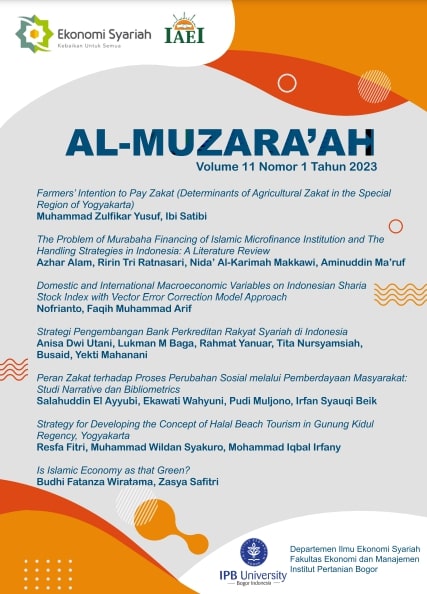Strategi Pengembangan Bank Pembiayaan Rakyat Syariah di Indonesia
Main Article Content
Abstract
The business growth of Islamic rural Bank (BPRS) in Indonesia is higher than conventional rural bank, meanwhile it has the lower market share. One of the reasons could be the intense competition faced by Islamic rural banks with another islamic finance institution such as baitul maal wat tamwil (BMT) and islamic commercial banks which have also penetrated into the MSME segment. It makes islamic rural banks are often called having middle child syndrome, which have no speciality in facing the markets. This study aims to identify the strategy to develop and deep the market of islamic rural banks in Indonesia. This study was conducted using primary data through interview and focus group discussion (FGD) and SWOT. The methods used are business model canvass (BMC) and SWOT. The results of this study identified five key factors that play an important role in the development of the BPRS industry, namely 1) capital factor, 2) human resource (HR) factor, 3) information technology infrastructure factor, 4) business model, and 5) regulatory aspect.
Downloads
Article Details

This work is licensed under a Creative Commons Attribution-ShareAlike 4.0 International License.
Author(s) who published in this journal agree to following terms:
- Authors understand and agree that copyright of manuscripts published are held by Al-Muzara'ah. The statement to release the copyright to Al-Muzara'ah is stated in form CTA (link doc).
- Copyright encompass exclusive rights to reproduce, to distribute, and to sell any part of the journal articles in all form and media.
This work is licensed under a Creative Commons Attribution-ShareAlike 4.0 International License (CC BY-SA) where Authors and Readers can copy and redistribute the material in any medium or format, as well as remix, transform, and build upon the material for any purpose, but they must give appropriate credit (cite to the article or content), provide a link to the license, and indicate if changes were made. If you remix, transform, or build upon the material, you must distribute your contributions under the same license as the original.
References
Akoten, J. E., Sawada, Y. & Otsuka, K. (2006). The determinants of credit access and its impacts on micro and small enterprises: The case of garment producers in Kenya. Economic Development and Cultural Change, 54(4), 927-944.
Anggraeni, L., Puspitasari, H., El Ayyubi, S., & Wiliasih, R. (2013). Akses UMKM terhadap pembiayaan mikro syariah dan dampaknya terhadap perkembangan usaha: kasus BMT Tadbiirul Ummah, Kabupaten Bogor. Al-Muzara'ah, 1(1), 56-67.
[APJII] Asosiasi Pengguna Jasa Internet Indonesia. (2022). APJII di Indonesia Digital Outloook 2022 [online]. [accessed 2022 Jun 9]. Retrieved from: https://apjii.or.id/berita/d/apjii-di-indonesia-digital-outloook-2022_857.
Ascarya. (2008). Akad dan Produk Bank Syariah. Jakarta (ID), Raja Grafindo Persada.
Cull, R. & Morduch, J. (2017). Development Projects: Microfinance Development Project - P095554, World Bank [online]. [accessed 2022 Dec 12]. Retrieved from: https://projects.worldbank.org/en/projects-operations/project-detail/P095554.
Dewi, G. (2007). Aspek-Aspek Hukum dalam Perbankan dan Pengasuransian Syari’ah di Indonesia. Jakarta ID, Kencana.
Hakim, A. A. (2011). Fiqh Perbankan Syariah: Transformasi Fiqih Muamalah ke dalam Peraturan Perundang-Undangan. Bandung (ID), Refika Aditama.
Nawawi, I. (2012). Fikih Muamalah Klasik dan Kontemporer: Hukum Perjanjian, Ekonomi, Bisnis, dan Sosial. Surabaya (ID), Ghalia Indonesia.
[OJK] Otoritas Jasa Keuangan. (2022). Statistik Perbankan Syariah - Juni 2022 [online]. [accessed 2022 Jul 9]. Retrieved from: https://ojk.go.id/id/kanal/syariah/data-dan-statistik/statistik-perbankan-syariah/Pages/Statistik-Perbankan-Syariah---Juni-2022.aspx.
[OJK] Otoritas Jasa Keuangan. (2022). Laporan Profil Industri Perbankan – Triwulan I 2022 [online]. [accessed 2022 Jul 9]. Retrieved from: https://www.ojk.go.id/id/kanal/perbankan/data-dan-statistik/laporan-profil-industri-perbankan/Pages/Laporan-Profil-Industri-Perbankan---Triwulan-I-2022.aspx.
Osterwalder, A. & Y. Pigneur. (2012). Business Model Generation. Jakarta (ID), PT. Elex Media Komputindo.
Rachman, L. H. (2014). Dampak Pembiayaan Syariah terhadap Profitabilitas Usaha Nasabah Bank Perkreditan Rakyat Syariah Harta Insan Karimah Kecamatan Ciledug Kota Tangerang. (Skripsi, IPB University, Bogor, Indonesia).
Salamah, S. S. (2015). Analisis Pengaruh Pembiayaan Ijarah terhadap Perkembangan UMKM (Studi Kasus BPR Syariah Amanah Ummah Leuwiliang Kabupaten Bogor). (Skripsi, IPB University, Bogor, Indonesia).
Zuhaily, W. (2001). Ensiklopedia Al Quran. Jombang (ID), Dar al Fikr.

